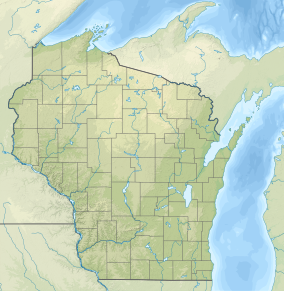| Kinnickinnic State Park | |
|---|---|
IUCN category V (protected landscape/seascape) | |
 The mouth of the Kinnickinnic River at the St. Croix River. | |
| Location | Pierce, Wisconsin, United States |
| Coordinates | 44°49′48″N 92°45′1″W / 44.83000°N 92.75028°W / 44.83000; -92.75028 |
| Area | 1,242 acres (5.03 km2) |
| Established | 1972 |
| Governing body | Wisconsin Department of Natural Resources |
| Website | Kinnickinnic State Park official site |
Kinnickinnic State Park is a 1,242-acre (503 ha) Wisconsin state park in which the Kinnickinnic River, locally known as Kinni River, joins the St. Croix River. The mouth of the Kinnickinnic River forms a sandy delta upon which boaters can picnic and camp.[1]
Flora and fauna[edit]
The banks of the Kinnickinnic River are lined with Weymouth pine trees. River is rich with trout.
More than 140 species of birds, such as anseriformes, visit the Kinnickinnic Valley during the bird migration [citation needed]. In the summer months, the number drops to 85 to 90 species, namely pheasants and grey partridges. In addition, there are also bald eagles in the winter months. In 1989, wild turkeys were resettled to the state park.
The mammal wildlife that frequent Kinnickinnic State Park include various species of white-tailed deer, raccoons, American minks, red and gray fox, Eurasian red squirrel, rabbit, weasel and North American beaver.
References[edit]
- ^ "Kinnickinnic State Park, a Wisconsin State Park located near Cottage Grove, Hastings and Hudson". www.stateparks.com. Retrieved September 26, 2023.
External links[edit]
| Authority control databases: National |
|---|


Well, that’s interesting to know that Psilotum nudum are known as whisk ferns. Psilotum nudum is the commoner species of the two. While the P. flaccidum is a rare species and is found in the tropical islands. Both the species are usually epiphytic in habit and grow upon tree ferns. These species may also be terrestrial and grow in humus or in the crevices of the rocks.
View the detailed Guide of Psilotum nudum: Detailed Study Of Psilotum Nudum (Whisk Fern), Classification, Anatomy, Reproduction